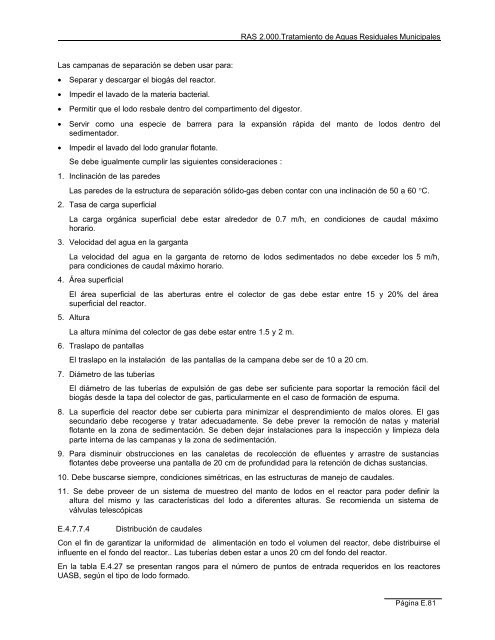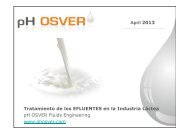7._Tratamiento_de_aguas_residuales
You also want an ePaper? Increase the reach of your titles
YUMPU automatically turns print PDFs into web optimized ePapers that Google loves.
RAS 2.000.<strong>Tratamiento</strong> <strong>de</strong> Aguas Residuales Municipales<br />
En la siguiente tabla se presenta un resumen <strong>de</strong> las cargas orgánicas aplicables en relación con la<br />
temperatura operacional para <strong>aguas</strong> <strong>residuales</strong> con VFA soluble y no-VFA soluble. Estos valores<br />
correspon<strong>de</strong>n a agua residual con un 30% <strong>de</strong> SS sedimentables en reactores UASB <strong>de</strong> lodo granular cuya<br />
concentración en el lodo es 25 kgssv/m 3 .<br />
TABLA E.4.25<br />
Cargas orgánicas aplicables en relación con la temperatura operacional<br />
Temperatura<br />
Carga orgánica volumétrica (kg/m 3·dia)<br />
°C<br />
VFA NO -VFA 30% SS-DQO Comentarios<br />
15 2 – 4 1.5 - 3 1.5 - 2 Remoción <strong>de</strong> SS<br />
satisfactoria<br />
20 4 - 6 2 - 4 2 - 3 Remoción <strong>de</strong> SS<br />
satisfactoria<br />
25 6 – 12 4 - 8 3 - 6 Remoción <strong>de</strong> SS<br />
razonable<br />
30 10 – 18 8 - 12 6 - 9 Remoción <strong>de</strong> SS<br />
mo<strong>de</strong>rada<br />
35 15 – 24 12 - 18 9 - 14 Remoción <strong>de</strong> SS casi<br />
pobre<br />
E.4.<strong>7.</strong><strong>7.</strong>1<br />
40 20 – 32 15 - 24 14 - 18 Remoción <strong>de</strong> SS<br />
pobre<br />
Tiempo <strong>de</strong> retención hidráulica<br />
Para el tratamiento <strong>de</strong> <strong>aguas</strong> <strong>residuales</strong> municipales <strong>de</strong>ben utilizarse tiempos mínimos <strong>de</strong> retención <strong>de</strong><br />
seis horas, que pue<strong>de</strong>n llevar a una remoción hasta <strong>de</strong>l 80% en la DBO 5 .<br />
El tiempo <strong>de</strong> retención aplicable a las <strong>aguas</strong> <strong>residuales</strong> municipales <strong>de</strong>pen<strong>de</strong> <strong>de</strong> la temperatura. En la<br />
tabla E.4.26 se presentan algunos valores aplicables para un reactor UASB <strong>de</strong> 4 m <strong>de</strong> altura.<br />
E.4.<strong>7.</strong><strong>7.</strong>2<br />
TABLA E.4.26<br />
Tiempos <strong>de</strong> retención hidráulicos aplicados a diferentes rangos <strong>de</strong> temperatura<br />
Rango <strong>de</strong><br />
Valores <strong>de</strong> trh (h)<br />
temperatura<br />
°C<br />
Promedio diario Máximo durante 4 -<br />
6 horas<br />
Pico aceptable<br />
durante 2-6 horas<br />
16 - 19 > 10 - 14 > 7 - 9 > 3 - 5<br />
22 - 26 > 7 - 9 > 5 - 7 > + - 3<br />
> 26 > 6 > 4 > 2.5<br />
Altura <strong>de</strong>l reactor<br />
El reactor pue<strong>de</strong> consi<strong>de</strong>rarse dividido en dos espacios, uno inferior en don<strong>de</strong> ocurren las reacciones <strong>de</strong><br />
<strong>de</strong>scomposición y uno superior en don<strong>de</strong> ocurre la sedimentación <strong>de</strong> los lodos. El espacio inferior <strong>de</strong>be<br />
tener una altura entre 4.0 y 5.0 m y superior entre 1.5 y 2.0 m. Adicionalmente <strong>de</strong>be proveerse un bor<strong>de</strong><br />
libre <strong>de</strong> 40 cm.<br />
E.4.<strong>7.</strong><strong>7.</strong>3<br />
Separador gas-sólido-líquido<br />
Esta estructura divi<strong>de</strong> el reactor en dos espacios : el inferior, que presenta alta turbulencia <strong>de</strong>bido al gas, y<br />
el superior o <strong>de</strong> sedimentación, con baja turbulencia. El separador provee <strong>de</strong> una superficie <strong>de</strong> contacto<br />
entre el líquido y el gas, <strong>de</strong> modo que los flocs que llegan a dicha superficie puedan transferir el gas que<br />
los ayuda a flotar a la atmósfera y sedimentar hacia la cámara principal.<br />
Página E.80






